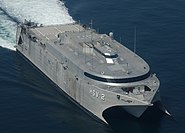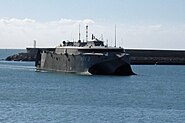| HSV-2 Swift | |
|---|---|
 | |
| Career | United States |
| Name: | HSV-2 Swift |
| Ordered: | October 2002 |
| Builder: | Incat, Tasmania, Australia |
| Yard number: | 061 |
| Acquired: | 15 August 2003 |
| Refit: | October 2008 |
| Homeport: | Naval Amphibious Base Little Creek, Norfolk, Virginia |
| Nickname: | Vomit Comet |
| Status: | In service; owned and operated by Sealift Inc. |
| General characteristics | |
| Displacement: |
1,668 long tons (1,695 t) full 940 long tons (955 t) standard |
| Length: | 321.5 ft (98.0 m) |
| Beam: | 88.6 ft (27.0 m) |
| Draft: | 11.15 ft (3.40 m) |
| Propulsion: | Caterpillar 3618 marine diesel engines |
| Speed: |
45 knots (83 km/h; 52 mph) maximum 30 knots (56 km/h; 35 mph) operating |
| Range: | 3,500 nmi (6,500 km; 4,000 mi) |
| Capacity: |
Approximately 605 long tons (615 t) Approximately 28,740 sq ft (2,670 m2) cargo deck |
| Complement: | 17 Contract Mariners; berthing for 107 with additional temporary berthing for 87 when seating is converted |
| Crew: | 35 |
| Armament: | 4 × .50 caliber M2 Browning machine gun mounts |
HSV-2 Swift is a non-commissioned, hybrid catamaran originally leased by the United States Navy as a mine countermeasures and sea basing test platform. She is now privately owned and operated by Sealift Inc. and chartered to the United States Navy Military Sealift Command. She is primarily used for fleet support and humanitarian partnership missions. The HSV stands for "High Speed Vessel", and its home port is Naval Amphibious Base Little Creek in Norfolk, Virginia. The vessel has two CONMAR crews that typically rotate every three months to keep the ship deployed eleven months per year. The minimum crew size is 35; 18 are military with the balance civilian, provided through American Maritime Officers and Seafarers International Union. On rare occasion that she is in a United States port, it is usually Naval Station Mayport, Florida, supporting the Fourth Fleet or Charleston, South Carolina, for major maintenance. Rota, Spain, is considered by the crew to be the "Mediterranean home away from home".[1]
Construction and acquisition[]
The ship was constructed by the Australian shipbuilder Incat in Hobart, Tasmania, and was leased to the U.S. Navy through Bollinger/Incat of Lockport, Louisiana. She was the second catamaran the Navy leased to test new technologies and concepts associated with the Chief of Naval Operations's "Seapower 21" plan. The contract value for the first year was $21.7 million. Swift is the fourth Incat-built high-speed wave piercing catamaran to enter military service, following behind HMAS Jervis Bay, U.S. Army Vessel (USAV) Theater Support Vessel Spearhead (TSV-X1) and HSV-X1 Joint Venture.
Design[]
It is a wave-piercing, aluminum-hulled, commercial catamaran with military enhancements, such as a helicopter flight deck, strengthened vehicle deck, small boat and unmanned vehicle launch and recovery capability, and an enhanced communications suite. It features a new, modular design, which will allow the ship to be refitted to support any mission without requiring long shipyard periods. While from the front the vessels appear to look like a trimaran, the centre hull does not rest in the water and is not used for buoyancy. As a logistics vessel, it does not have water-tight compartments or weapons systems. Its propulsion is provided by directional water jets, so it doesn't have propellers or a rudder for steering and can maneuver in twelve feet of water.[1]
Operational history[]
The first ship of this class to be used by the Navy, Joint Venture, proved its military mettle during the 2003 invasion of Iraq as a forward staging platform for Marine Fleet Anti-Terrorism and United States Navy SEAL (SEa, Air, Land) teams in the shallow waters of Umm Qasr, Iraq. The Navy hopes to build upon lessons learned from Swift and its predecessor, and eventually use the information to create a new class of littoral combat ships.
In the autumn of 2003, while operating with the Fifth Fleet, Swift completed the fastest-ever transit of the northern Great Barrier Reef from Cairns to Booby Island, Australia, averaging slightly over 39 knots (72 km/h). During flight deck certifications, Swift's crew conducted aircraft recovery while making 43 knots (80 km/h) during one recovery and had 66 knots (122 km/h) apparent winds during another recovery.
In November 2003 she began West African Training Cruise-04. She first visited the South African Navy base at Durban on 3 November 2003. She then exercised with the SAN and SAAF off Simon's Town in the Western Cape. As of early Nov 2003, as reported by Jane's Defence Weekly, 19 November 2003, exercises were also planned with Cameroon, Gambia, Ghana, Morocco, Senegal, and Sierra Leone. Swift had embarked a small United States Marine Corps detachment for the cruise, 'which will draw on Norway Air-Landed Marine Expeditionary Brigade equipment for the exercises.'[2] The JDW story said that Marine reservists will practice with the NALMEB equipment, and the cruise would also be used to evaluate an experimental lightweight ROWPU that was at that time being tested by the USMC warfighting laboratory. She returned in early 2004.
In 2004, Swift was tapped to provide logistical assistance during the Tsunami Relief Effort in North Sumatra. Swift proved its capabilities and flexibility in numerous ways, giving the U.S. Navy a new view. The Swift Crew, prepared for the new and sudden change of orders in less than one week's time. The two crews performed the fastest crew swap ever in Pearl Harbor, with Gold crew relieving Blue crew in less than eight hours. Once on station, Swift embarked her first ever helicopter detachment, providing a base of operations for the two helicopters and their crew for 30 consecutive days at sea. Swift crew also conducted many firsts for the unique vessel, including 30 straight days at sea, supporting a helicopter detachment and its support crew with high tempo flight operations as well as conducting two underway replenishments. Upon detaching from the relief effort, the crew then took Swift through her first transit of the Suez Canal. The Swift was also the first U.S. Naval ship to be certified for 100% electronic navigation, removing the centuries old requirement for ships to carry a full complement of navigation charts. Swift is used to test experimental equipment, with the crews reporting back on the effectiveness of the new equipment.
During the 2006 Israel-Lebanon conflict, HSV-2 Swift was used to transport humanitarian assistance materials from Cyprus to Beirut.
Since departing Naval Station Mayport, Florida on April 25, Swift serving as a Global Fleet Station (GFS) hosted more than 1,000 host nation military and civilian personnel during twelve visits to seven countries such as Belize, Dominican Republic, Guatemala, Honduras, Jamaica, Nicaragua and Panama. In these countries, personnel on board Swift conducted 39,890 hours of subject matter expert exchanges in such areas as leadership, small boat operations, port security and small unit tactics.
The six-month US Navy sponsored GFS deployment tested the Navy’s GFS concept, a maritime security cooperation initiative aimed at strengthening global partnerships through training and cooperation activities. The Swift transported US military training teams to conduct maritime training with regional civil and maritime services.
During the last half of the deployment, more than 20,000 lb (9,100 kg) of medical and food supplies were donated through Project Handclasp. The Swift hosted numerous dignitaries, including the Prime Minister of Jamaica and U.S. Ambassadors to Panama, Guatemala, Nicaragua, Honduras and Jamaica.
The GFS completed its pilot mission, Sunday, September 30, when the Swift returned to Naval Station Mayport, Florida.
On May 5, 2010, HSV-2, along with various embarked Navy and Marine Corps units, departed Naval Station Mayport for a five-month deployment for Southern Partnership Station (SPS) 2010.
- While in port, Swift received 140 Project Handclasp pallets and two fire engines. The Wisconsin National Guard State Partnership Program donated the fire engines to Project Handclasp for transportation to Nicaragua, their partner nation.
- Project Handclasp is a U.S. Navy program that accepts and transports educational, humanitarian and goodwill material on a space-available basis aboard U.S. Navy ships for distribution to foreign nation recipients.
- SPS is an annual deployment of various specialty platforms to the U.S. Southern Command (USSOUTHCOM) area of responsibility (AOR) in the Caribbean and Latin America. The mission's primary goal is information sharing with navies, coast guards, and civilian services throughout the region.[3]

Swift with Tethered Aerostat
In April 2013, a TIF-25K Tethered Aerostat (unmanned blimp) was tested from the stern of HSV-2. The aerostat can be positioned 3,000 feet above the vessel for surveillance.[4]
Swift will be replaced with USNS Spearhead (JHSV-1) when that vessel comes into service.[5]
Swift returned to Incat at Hobart in July 2013 for refit for sale or charter.[6]
Gallery[]
Related developments[]
- HMAS Jervis Bay (AKR-45) (Royal Australian Navy)
- HSV-1 Joint Venture (US Navy)
References[]
- ↑ 1.0 1.1 Brumley, Jeff: "Unusual ship visits Mayport after 6-month deployment to African waters" Florida Times-Union, October 5, 2011
- ↑ Helmoed-Romer Heitman, 'US Navy catamaran on training cruise off West Africa,' JDW 19 November 2003, p.19
- ↑ Wood, Robert (2010-05-06). "HSV 2 Swift Departs for Southern Partnership Station 2010". http://www.navy.mil/search/display.asp?story_id=53131. Retrieved 2010-11-26.
- ↑ Allen, Sean (2013-01-05). "USNS Swift Completes Aerostat and UAV Testing, Departs Key West for Operation Martillio". http://www.navy.mil/submit/display.asp?story_id=73794. Retrieved 2013-08-01.
- ↑ Cavas, Christopher P. "Interview: U.S. Navy Rear Adm. Mark Buzby." Defense News, 15 October 2012.
- ↑ Nick Clark (July 30, 2013). "Swift returns to Hobart". The Mercury. http://www.themercury.com.au/article/2013/07/30/384595_tasmania-news.html.
This article was based on numerous Navy public domain press releases.[specify]
External links[]
| Wikimedia Commons has media related to HSV-2 Swift. |
| ||||||||||||||
The original article can be found at HSV-2 Swift and the edit history here.






